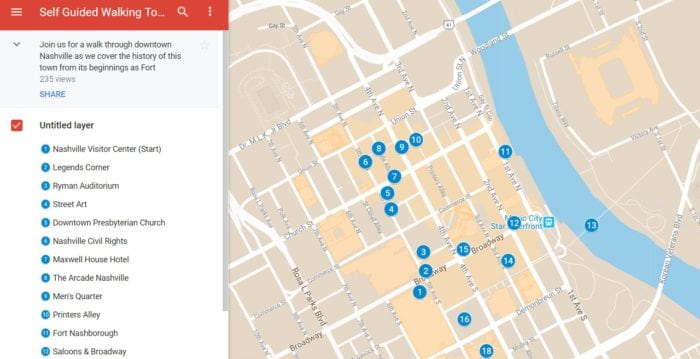Our tour guides spend a lot of time exploring the city of Nashville and learning about its history, and they've come up with a pretty impressive self-guided tour of the downtown area.
Join us for a walk through downtown Nashville as we cover the history of this town from its beginnings as Fort Nashborough through the Civil War, Civil Rights, and Country Music to today.
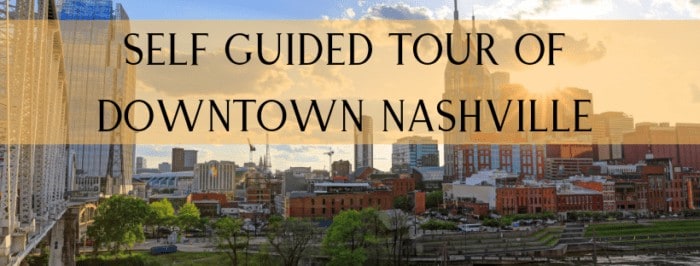
The whole tour takes about 2 hours - that is if you don't step inside any of the museums or restaurants.
Audio Tour
We also offer this self-guided tour in an audio format.
Here is how it works:
- Purchase an audio tour from our Booking Page.
- You’ll receive a confirmation email with a .pdf, Google Map link, and audio tour.
- Enjoy the tour(s).
Listen to a sample of our Downtown Nashville Tour:
Self-Guided Walking Tour of Nashville:
- Nashville Visitor Center (START)
- Legends Corner
- Ryman Auditorium
- Street Art
- Downtown Presbyterian Church
- Nashville Civil Rights
- Maxwell House Hotel
- L&C Tower
- The Arcade
- Men's Quarter
- Printer's Alley
- Fort Nashborough
- Saloons
- Shelby Street Pedestrian Bridge
- Goo Goo Shop
- Honky Tonk Highway
- Music City Walk of Fame (END)
- Hatch Show Print (Optional Stop
- Nashville Celebrity Homes Tour
501 Broadway
Nashville Visitor Center (START)
We begin our tour of Nashville here at the Visitor Center.
You can go inside to grab a bottle of water or use the restrooms before we get started, but we're about to venture on a 2-mile walk together so maybe hold off on the souvenir shopping.
We end the tour not far from here so you can always come back.
We will talk about the history of Nashville at a later stop and how it got started, but let's use this stop to talk about what Nashville is today.
Nashville is the capital of Tennessee and of country music. These are two facts that most people know about the city already.
But did you know that there is a huge printing industry here? Or that Maxwell Coffee is from Nashville? We'll talk about this and more on our tour.
Nashville's nickname is Music City. Depending on what time of day you are standing at this corner, you may be able to see why the name has stuck.
Live music is played most of the day and night somewhere in the city. But this isn't how the nickname got started. It all began with ... the Queen of England. No, seriously.
Fisk University, a historically black university, was founded in 1866 just after the end of the American Civil War, as a school for freedmen.
As part of a way to raise funds, the Fisk Jubilee Singers a capella group toured around the country and Europe.
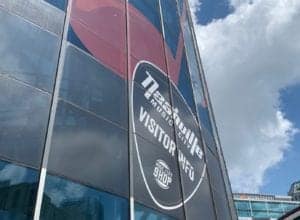
After singing for the Queen of England she remarked: "You must be from Music City." This nickname was cemented in the 1950s by a radio announcer at WSM (home of the Grand Ole Opry).
Music is a part of the city's soul but it isn't only country music. You can find any genre being performed, recorded, and played here.
But let's be honest, country music is what Nashville is known for and our next stop is going to introduce you to some of our city's favorites.
From here you can see the start of Honky Tonk Highway, including one of its famous bars. You really can't miss it. Look for the bright purple building. That is Tootsie's Orchid Lounge.
It was originally a bar called "Moms" when Hattie Louise Bess bought it in the 1960s. She named it after herself, Tootsies.
When the painter accidentally painted the building this color of purple - orchid - it became the bar's signature and stuck.
Tootsie was where many people got their start - including Willie Nelson who got his first songwriting gig after singing there.
One story that embodies the southern hospitality and family of country music. Tootsie was known to slip cash into the pockets of struggling artists or accept IOUs at the bar.
At the end of the year, musicians who had made it would pay the IOUs so Tootsie would not lose the money.
Tootsie's acted as the Ryman's unofficial green room where musical acts would sneak in the back door of the bar to play something new or grab a beer, something you couldn't do at the Ryman.
As much as music has a unique history here in Nashville, so does liquor. Particularly the kind that came from bootlegging - moonshine and whiskey.
Tennessee passed laws in 1908 that effectively created Prohibition in the state years before the federal government and it wasn't until the 1960s that you could get a cocktail with dinner.
A lot of Nashville establishments were popularized because of backdoors that let patrons and musicians get a drink.
From here cross the street diagonally (in Nashville many of the intersections have diagonal crosswalks!) to the mural on the side of Legends Corner)
Legends Corner
Legends Corner is one of the most popular country bars in Nashville. From here on down Broadway, we call this Honky Tonk Row so there are a lot of country bars.
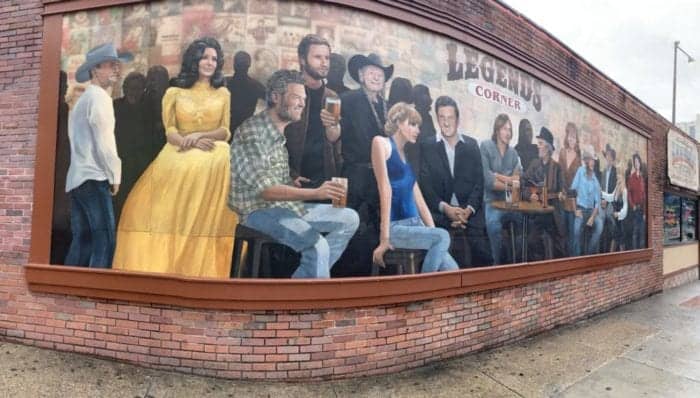
On the side wall along 5th Street is a new mural depicting famous faces of country music: Tim McGraw, Loretta Lynn, Blake Shelton, Dierks Bentley, Willie Nelson, Taylor Swift, Johnny Cash, Keith Urban, Merle Haggard, Reba McEntire, Alan Jackson, George Strait, Dolly Parton, and Garth Brooks.
You'll notice some shadowy figures in the background. These are placeholders for additions of future country legends.
Continue up 5th Avenue North to the red brick building. While it looks like a church, today it is the Ryman Auditorium and is called the Mother Church of Country Music.
This sidewalk is narrow and crowded so we'll have you go around the corner but as you walk along the 5th Avenue side of the building, look up above the door and you'll see an engraving that says Union Gospel Tabernacle.
Stop around the corner for a good view of the stained glass windows and quiet place, but you can also continue around the building to the front entrance on 4th Avenue if you want some more photo ops or to pause this and take the self-guided tour inside the Ryman.
Ryman Auditorium
To start you off, there is more to say and see about Ryman Auditorium that can we share with you and stay on time.
We highly recommend touring inside. Read our post about how to do that.
This is the mother church of country music and it was built as a church.
The story goes that Thomas Ryman, a rich man who had his hands in many money-making schemes in Nashville, went to confront a traveling preacher named Sam Jones who had set up a tent revival outside of town.
However, after hearing him preach, Ryman didn't want to tell Sam Jones to leave - he asked him to stay and decided to help build a church, the Union Gospel Tabernacle.
The first concert was held on May 4, 1892.

The May Music Festival with the Theodore Thomas Orchestra was a fundraising concert to help the Ladies Hermitage Association purchase items for Andrew Jackson's home (which we also recommend visiting).
It is a performance venue today hosting acts from all over the world and of all genres, but what it is most known for is the Grand Ole Opry.
There is a lot of confusion about the Ryman vs. the Grand Ole Opry House and you will understand it better if you tour inside one or both of these buildings.
The Grand Ole Opry is a show. The Ryman was the home to this radio show from its beginning in 1943 until it moved to a new purpose-built building, what is called the Grand Ole Opry House, in 1974.
It was an emotional farewell when the Opry (show) left the Ryman and as a symbolic way to bring a piece of the Ryman to the new location, they did just that.
A portion of the stage floor was cut out in a circle and inlaid on the new Opry House floor.
Continue up 5th Avenue crossing Commerce Street. You'll walk past a parking garage with a giant mural. Once you get past the entrance to the parking garage, stop and turn around. You'll see another street art mural on the side of the building.
Street Art
Nashville has a surprising amount of street art. So much in fact that we have more self-guided tours dedicated to it!
Graffiti? Street Art? One is wanted, and one is not.
Street art and murals have been commissioned around the city to beautify shop walls, garages, and more.
The Nashville Walls Project brings internationally acclaimed and local artists to contribute to these artworks.

This building has a few pieces:
- The mural on the street side is done by Beau Stanton as part of a project with Rivive, a nonprofit dedicated to cleaning up the Cumberland River.
- The lyrics on the corner are from a Johnny Cash song, As Long As the Grass Shall Grow, done by Niels Shoe Meulman.
Keep an eye out as we walk around, around corners and the backs of buildings for more art.
Continue up 5th Avenue walking along a church on your right. The Downtown Presbyterian Church is our next stop but its best to stop on 4th Street at the entrance.
Downtown Presbyterian Church
This current church building is the third on this site, the first two having burnt down. What is unique about this building is the architectural style.
The architect, William Strickland, who also designed the Tennessee State Capitol, was inspired by the images from Egypt during the height of archeological discovery in the mid-1800s.

The Downtown Presbyterian Church is one of the best examples of Egyptian Revivalism in the U.S.
Look for the lotus columns and a winged sun disk and if you have a chance go inside.
The painting inside the church feels like an Egyptian temple.
Like most churches during the Civil War, this served as a Union hospital.
You may not have expected this to be a Union hospital as Tennessee seceded and joined the Confederacy during the American Civil War.
Tennessee was very much a divided territory - it was the last state to secede and the first state to rejoin the Union.
Nashville was the first Confederate state capital to fall to Union control as a strategic point on the river.
Cross Church Street to continue up to 5th Avenue, looking for Woolworths on 5th, which will be across the street.
Nashville Civil Rights
This stretch of 5th Ave became a central shopping district after the Civil War. As a commercial district, this was the location of many of the sit-ins during the American Civil Rights Movement.
This street had many "five and dimes", including an F.W. Woolworths. After the Greensboro sit-ins, this nonviolent campaign to end racial segregation spread across the South.
The idea of sit-ins at lunch counters was already discussed in Nashville before this historic event in Greensboro, North Carolina.
Many of these commercial establishments allowed anyone to shop, but not eat at their restaurants.
On Saturday, February 13, 1960, more than 100 students would sit at lunch counters at various establishments on this street - Woolworths, Kress, McLellan, Walgreens, and Harveys.
They were refused service but sat at the counter for two hours before leaving.
This would happen many more times over the next few weeks. The demonstrators never reacted to any verbal or physical taunts and the sit-ins would often end with their arrest.
After the sit-ins and protests of downtown segregated merchants, meetings were held in secret between the student activists and the stores.
A controlled integration began and Nashville was the first major city in the South to desegregate.
Go back to the corner of Church and 5th and turn left onto Church Street. As you cross Arcade Alley, look for the historic marker on the wall on your left.
Maxwell House Hotel
The building you see before you stands on the site of the old Maxwell House Hotel, which burned down in a fire on Christmas in 1961, the cause still unknown.
The hotel construction began in 1859, which means the original construction was completed by enslaved men. Though the building was not completed, this became a Union hospital and prison during the Civil War.

When the Civil War ended and the Union forces left, the first meeting of the Ku Klux Klan was held here in 1867.
The hotel was opened to the public in 1869, advertising steam heat, gaslighting, and a bath on every floor. Rooms cost $4 a day, including meals and coffee.
The hotel enjoyed a fine reputation during its height and hosted a veritable who's who of visitors, including 8 presidents.
When President Teddy Roosevelt was staying here he is reported as commenting that the coffee served was "Good to the Last Drop" - a slogan Maxwell House coffee continues to use to this day.
Whether this story is true is debated, though Roosevelt did have Maxwell House coffee during a stay, he said "This is the kind of stuff I like to drink, by George, when I hunt bears" - which just doesn't have the same ring to it.
There is a small alley that you crossed over to see the plaque, turn right down Arcade Alley until you get to the Arcade-covered shopping area.
The Arcade
This used to be Overton Alley until a local business was inspired by the Galleria Vittorio Emmanuele in Milan, Italy, and convinced the shops and restaurants to create an enclosed walkway.
It was such a draw for local residents that when it opened in 1903 more than a quarter of the city population showed up.
Can you imagine being in here with 40,000 people?
When you exit the covered area be sure to turn around and look at the columned entryway.
If you haven't already walked through, get to the end of the Arcade on 4th Street. Turn right for just a few steps.
We will eventually cross 4th Street at this crosswalk but for now, look at the historic Victorian building across the street. At the time of writing, it still has the Southern Turf sign but the building has been sold to a new owner to become a Frank Sinatra-themed bar.
Men's Quarter
If you were a woman of any decency, you would not be caught even walking down this street at the turn of the 20th century.
This block down to the corner where the Maxwell House Hotel stood was known as the Men's Quarter.
It was full of saloons, barbershops, suit sellers, and gambling and its reputation was so known that the Maxwell House Hotel had a separate Ladies' Entrance on the other side of the building.
The building across the street, the Southern Turf, was one of the finer establishments, feeding off the high-class clientele of the hotel across the street.
It had mahogany furniture and bronze statues, and even electric fans.
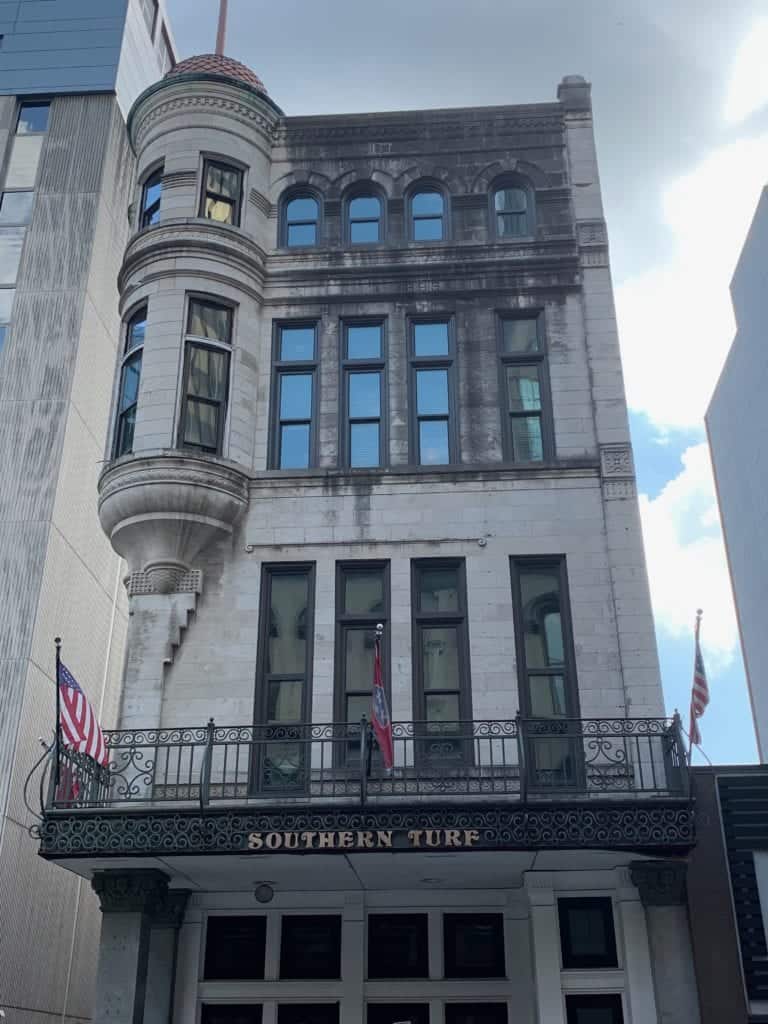
A few doors down, the Utopia was a 6 story building with an elevator that ran all night.
The Climax Saloon had an upper floor for prostitution that had false walls where working girls could hide if there were a police raid -which there were not too many of. Lax enforcement allowed this area to thrive.
In its heyday, the local whiskey distilleries supplied the saloons - including Jack Daniels who could be seen walking around from bar to bar buying rounds of his whiskey for the patrons.
Despite its reputation, don't picture it as a rough and tumble, seedy area. The businesses maintained opulent appearances, and clean streets with no obvious acts of impropriety.
But even nice-looking and well-behaved drunks are still drunks and as the temperance movement swept the nation, Tennessee enacted Prohibition in 1914 closing all the saloons.
Cross 4th Avenue and head down alongside the Southern Turf building. This is called Bank Alley. Stop when you get to the next intersection and look to your right.
Printer's Alley
Printer's Alley today is a hub of lights and sounds for Nashville's nightlife and owes its beginnings as such to the closing of the saloons after the state Prohibition.
But its name, Printer's Alley, comes from before that. Here were the offices of the newspapers and publishing houses. In 1915 there were 13 publishers and 10 printers.
The last printer did not leave the ally until 1977.
During Prohibition, this was the home to speakeasies and restaurants who claimed their patrons had brought in their own liquor, or "brown bagged" it. It was not until 1968 that venues could sell alcohol.
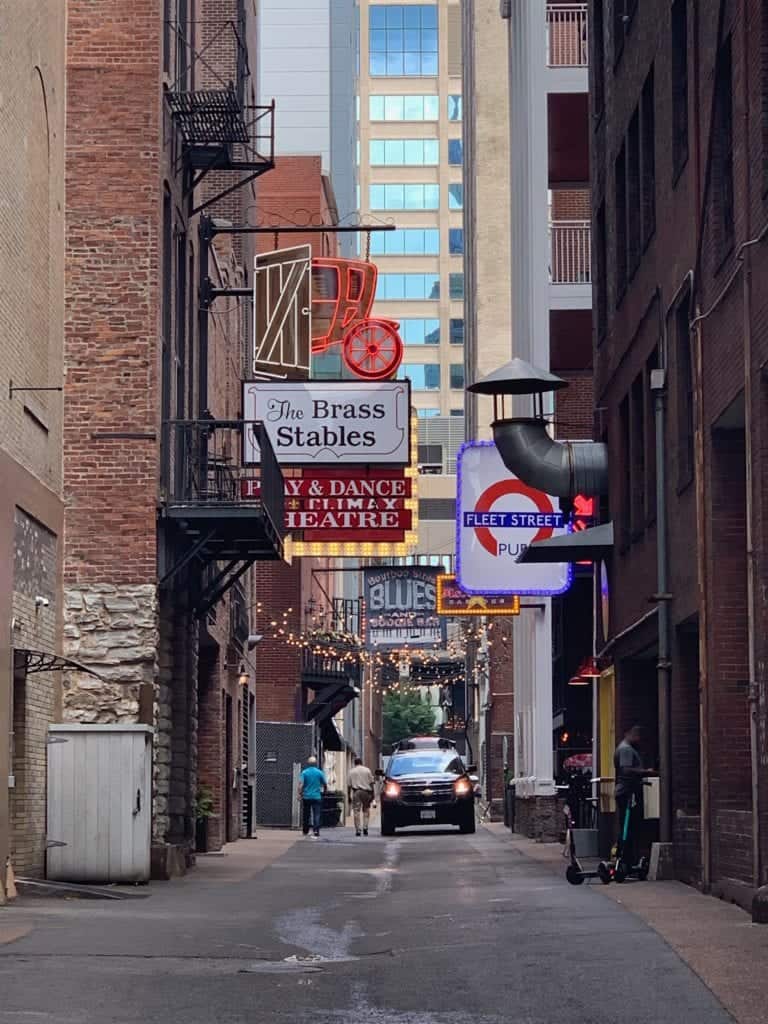
You would find a variety of musicians playing here at the nightclubs, including country musicians who wanted to jam to a little jazz after their studio sets.
Chet Atkins, Waylon Jennings, Dottie West, The Supremes, and Hank Williams all played here.
If you want to come back here at night, Bourbon Street Blues is the best blues bar in town.
Skull's Rainbow Room is a unique Nashville experience with a storied past. This is the basement of the Southern Turf building, the opulently decorated saloon in the Men's Quarter.
It was opened in 1948 by David "Skull" Schulman. It had comedy - Andy Griffith and Jerry Lee Lewis. It had exotic dancers. It had live music.
Skull was voted the Mayor of Printer's Alley and would walk his pet poodles (one of them a gift from Elvis) down the street on rhinestone-studded leashes.
The checkered stage you would see if you went inside today is the original. Willie Nelson played as part of the house band and Elvis, Johnny Cash, Joni Mitchell, and Bob Dylan played here.
Tim McGraw started out here after Skull loaned him some money and brought some people from the industry to see him play.
Both back then and today, you'll find a burlesque show in the evenings. It feels like a speakeasy even today.
After he was murdered in 1998, the Rainbow Room closed not to be reopened again until 2015.
The new management did as much as it could to restore the original character and you'll find a lot of items from the original Rainbow Row. If you can visit, you should.
If you haven't already, walk down Printer's Alley. There is a great photo op of the Printer's Alley sign when you get to Church Street. Turn left on Church Street. It will be a few blocks until our next stop, which you'll see when Church Street ends at the Riverfront.
Fort Nashborough
The first people in this area were Native Americans, the Cherokee, Chickasaw, and Shawnee, and later French fur traders.
In 1779, James Robertson came from what is now western North Carolina to establish a settlement on the Cumberland River.
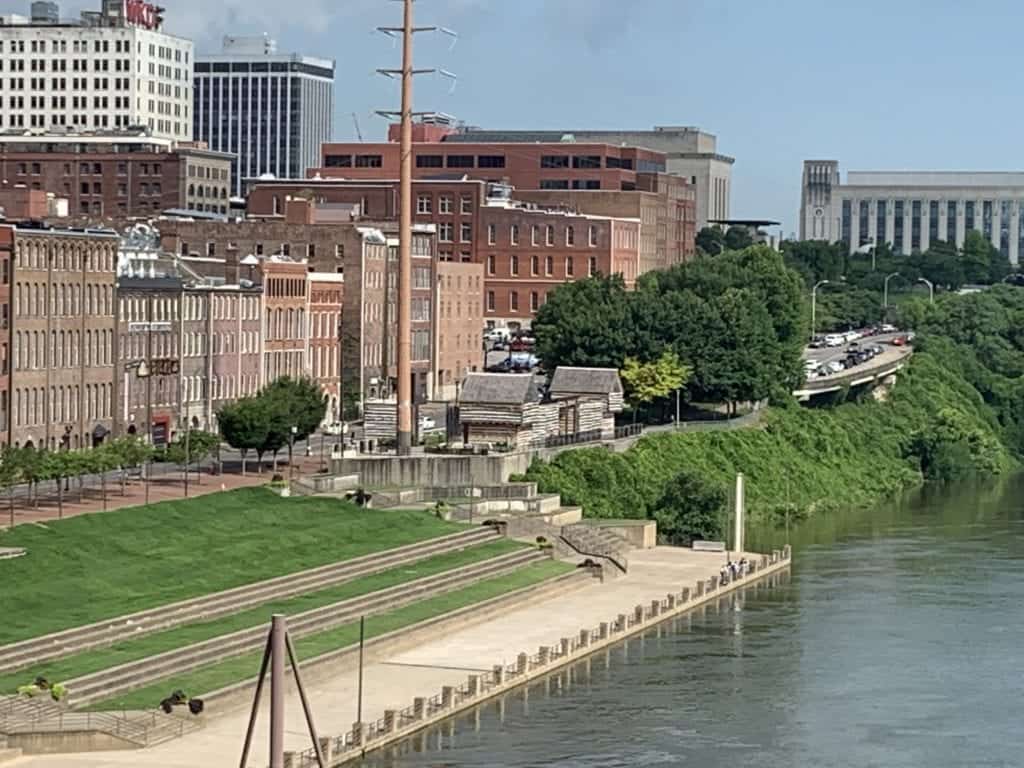
Robertson and the settlers who arrived in 1780 called it the Bluff Station but records refer to it as Fort Nashborough, after Francis Nash. He was a North Carolina politician and Revolutionary War general who died in battle.
It was officially designated as the town of Nashville in 1784 and was part of the state of North Carolina. It became the state capital of the newly admitted state of Tennessee in 1796.
As was common back then, the capital of a state moved occasionally - Knoxville and Murfreesboro had been capitals as well. Nashville became the official permanent state capital in 1843.
What you see here is a recreation of the original wooden stockade. Feel free to walk around and have a look at the buildings and historical markers.
With the river to your left, walk along 1st Ave North. You'll at some point want to cross 1st Ave North to be on the far side of the road. Stop when you get to Broadway.
The building on the corner will say Hard Rock Cafe but peek around the corner for a look at what it used to be. There is a great mural on the side of the building.
Turn on Broadway and stop at the corner of 2nd Street. This red brick building is still technically part of the Hard Rock Cafe today.
Saloons
This Victorian building used to be the Silver Dollar Saloon.
If you were to keep walking up 2nd Street you'd be making your way towards the infamous Men's Quarter, but the Silver Dollar Saloon catered to a different clientele ... the boatsmen from the river.
Like many of the drinking establishments, this one was run by a whiskey distillery, George A. Dickel Whisky Company, as a way to serve their product to the masses.
Dickel also owned the Climax Saloon back in the Men's Quarter.

The Honky Tonks along Broadway today often have people outside, encouraging you to come on in. This would have been the case back then as well.
Look up Broadway and you'll see two spires in the distance. If you had an eyeglass you would be able to see the clock on top of Union Station (now a hotel) all the way from the waterfront.
The saloons here would send runners up to the train station to see what the timetables were like and then come back as the boats were unloading.
"Hey, anyone on the 3 pm? It's delayed until 4 pm, come on in for a drink!"
Cross Broadway. You're crossing the end of Honky Tonk Highway but we'll come back to it!
Continue along 2nd Avenue until you see the steps and elevator to take you up to the Pedestrian Bridge (just next to Joe's Crab Shack)
Shelby Street Pedestrian Bridge
You can choose how far to walk along but we suggest going about halfway to find an overlook on the left for that great view of the Nashville skyline.
Looking across the river to your right, that is the Nissan Stadium, where the Tennessee Titans play.
Looking to the left is the skyline of Nashville. Notice the tallest building - we call this the Batman Building. For obvious reasons.
The AT&T building was even named one of the most unique office buildings in the world and referred to by a French magazine as "Le Bat Tower"
In the cluster of highrises, you can also see the L&C Tower. For years this was the only skyscraper in Nashville. It stands just across the street from the site of the Maxwell House Hotel.
When it was completed in the late 1950s at 409 feet and 31 stories tall it was the tallest building in the Southeast.
Insurance was a big part of the industry here in Nashville and has a connection to a local institution that you probably wouldn't expect.
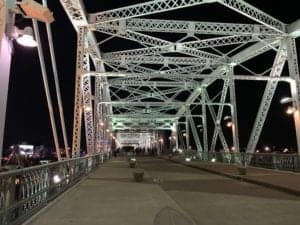
After the L&C Tower building was completed, another insurance agency headquartered in Nashville decided to build a taller building to rival the L&C.
The National Life and Accident Insurance building is now unremarkable in the Nashville skyline so much so that you cannot really see it from here.
When this company began in 1900, it was headquartered in a much smaller building downtown.
On November 28, 1925, on the fifth floor of the old building, a radio show called the WSM Barn Dance began.
WSM was a clear coast-to-coast channel owned by the insurance company as part of their marketing efforts. WSM stands for their motto, We Shield Millions.
The Barn Dance musical hour came on the radio right after a Music Appreciation Hour, which often played Opera Music. And one night in 1927, the radio announcer said:
"For the past hour, we have been listening to music taken largely from Grand Opera. From now on, we will present the "Grand Ole Opry."
The Grand Ole Opry Show was owned by an insurance company. This was a time of the door-to-door salesmen. The only way they could sell their policies was to get you to open your front door.
And what better way to get someone to open the door than to announce "I'm with the Grand Ole Opry" when you knock?
Turn back and walk down the Pedestrian Bridge, you don't need to take the elevator or stairs - head down the ramp and turn right onto 3rd Ave S. Stop outside the Goo Goo Shop.
Goo Goo Shop
Before you stop in for a treat, let me tell you about this classic Nashville candy.
Most of our beloved candy bars started out as mom-and-pop operations like this one, but Goo Goo never sold out to a larger corporation and you can still only get them from certain sellers.
The Standard Candy Company created this combination of caramel, peanuts, and marshmallow in 1912. It is considered the world's first combination candy.

If this trio isn't to your taste, you can make your own Goo Goo Cluster inside the store by picking a few fillings and they'll put it in a chocolate mold right in front of you.
The origin of the name Goo Goo is still up for debate, but the story goes that the candy was sold without a formal name while the matter was decided.
After the birth of the inventor's son, he was chatting with folks on the streetcar and mentioned his son's first words: Goo Goo.
A teacher remarked that should be the name! It is so good, people will ask for it from birth.
Now, go inside and get one to try for yourself.
Did you go inside to get a cluster? Do that first! And then keep walking along 3rd Ave S to get to Broadway.
Honky Tonk Highway
We've talked about the history of drinking, music, and some of the original bars at either end of this stretch of Broadway. As we walk up one block of it, let's go over what a Honky Tonk is.
The term Honky Tonk is both a type of music and a bar that plays it. It's associated with country music and many of your favorite country musicians got their start in one.
You will still find up-and-coming artists performing on Honky Tonk Highway today.
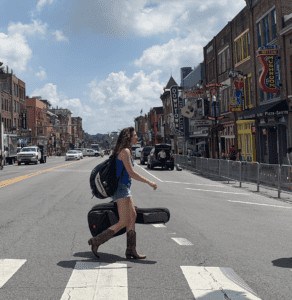
It's a strange term and no one quite knows where it came from, though most likely it originated in the 1800s American South and West along cattle routes.
It originally referred to a type of theatre and show.
The theatre always had a bar - a loud one. These establishments had live music, dancing, gambling, drinking, and sometimes prostitution.
And it was for the working man, not a high-class establishment like the Southern Turf.
After a while, the rough and tumble-scene at a honky-tonk became associated with a certain style of music.
This music focused heavily on rhythm - especially considering the pianos in these bars often were out of tune and missing keys.
The music has evolved but you still get a sense of old West working cowboys in these Honky Tonks.
Walk along Broadway for one block, cross, and turn left onto 4th Ave. Our next stop is around the corner so you won't be far if you want to come back to Broadway.
You'll pass a few buildings and after the Hilton Hotel come to a large open park on your right. Head through the park to the far side, you should see the stars on the sidewalk. Pick your favorite Country star!
Music City Walk of Fame (END)
Much like the Hollywood Walk of Fame, these stars are in honor of the men and women who have contributed to Music City.
Many people think of it as the Country Music Walk of Fame, but in reality, it honors anyone in the music industry of all genres who have an association with Nashville.
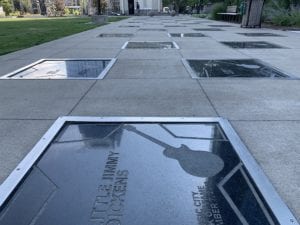
But look at the building across the street, the Country Music Hall of Fame. When we finish the tour, this is a highlight of a trip to Nashville.
Read our post about how to get concessions on tickets.
What most people don't notice about the building is the architecture. Look closely and you'll see a drum, piano keys, and a radio tower on top of a stack that looks like the evolution of record sizes.
To the right, the corner of the building looks like the tailfin of Elvis' Cadillac, which you can see inside.
The stone bars are the music notes for "Will the Circle Be Unbroken" - sung as the finale at the last Grand Ole Opry at the Ryman.
We end the tour here so you can easily head back to Broadway or back to the Visitor Center (just walk through the park to 5th Street and turn right) but if you want to continue, there are a few nearby attractions you may want to visit:
- Hatch Show Print
- Country Music Hall of Fame
Nashville Celebrity Homes Tour
Delight in Music City's allure straight from your vehicle with the enthralling Nashville Celebrity Homes Tour.
This self-guided, driving tour of Nashville offers an individualized journey, blending flexibility and privacy.
A detailed do-it-yourself driving map helps you explore Nashville's renowned neighborhoods leisurely, showcasing the stunning residences of esteemed music stars and celebrities.
This complete guide reveals the locations of several high-profile celebrity homes in Nashville, from Taylor Swift to Keith Urban and Dolly Parton.
Each turn introduces another facet of Nashville's glamorous living.
The charm of this tour is your control over the route and time spent at each site.
Perhaps you'd like to linger at a specific star's magnificent residence or take a short side trip to a celebrated Nashville eatery.
Should you favor a more guided experience with insider stories about the stars and their homes, there are also organized celebrity home tours available in Nashville.
These tours offer expert guides with rich insights and fascinating tales that the self-guided tour can't provide.
Whichever option you choose, you're guaranteed a unique, star-filled escapade.
Discover the Nashville Celebrity Homes Tour and download your Nashville driving tour map today.




